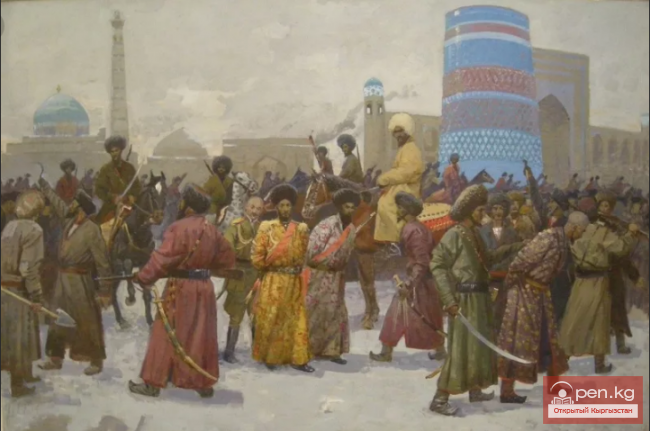The Uprising of 1916 in Kyrgyzstan
The Uprising of 1916 in Kyrgyzstan was an organic part of the movement of the peoples of Central Asia, Kazakhstan, and some other national outskirts of Tsarist Russia, involving more than 10 million people. In Kyrgyzstan, especially in its northern regions, where the indigenous population was displaced from their settled lands, it took on an unprecedented scale and mass character. The protests here were marked by their duration and persistence. This uprising, which inscribed a new bright page in the history of the liberation movement of the peoples of Central Asia, was directly linked to the socio-economic and political situation that had developed in this region of the tsarist empire in the early 20th century, characterized primarily by the harsh colonial oppression of the autocracy and local feudal nobility, the worsening conditions of the working masses, exacerbated by the difficulties of wartime. The immediate catalyst for the outbreak of popular anger was the imperial decree issued on June 25, 1916, regarding the mobilization of the indigenous male population of Turkestan and Kazakhstan for military rear work, specifically targeting men aged 19 to 43. A total of 200,470 people were to be recruited from the Turkestan region, including 4,300 from the Semirechye region and 51,233 from Fergana.
The open protest of the workers in the city of Khojent on July 4 served as a signal for the spontaneous beginning of the 1916 uprising in Central Asia and Kazakhstan. News of the brave stand and firm resolve of the workers of Khojent to oppose the authorities spread throughout the region like wildfire.
The uprising began to encompass new areas and broader layers of the population. By the second and third decades of July, the entire Fergana region, including the southern part of Kyrgyzstan, was engulfed in the flames of popular uprising.
The Osh district was not left out of the uprising either. Its working population, primarily consisting of Kyrgyz, also sought to settle scores with the hated tsarist officials, volost administrators, and village elders. In other words, here too, the uprising transcended mere protest against the implementation of the tsarist decree on mobilization for rear work, taking on the characteristics of an anti-feudal movement of the masses.
In early July, serious unrest occurred in the city of Osh. After the "highest command" regarding the recruitment of workers was received, about 10,000 people gathered at the foot of Suleiman Mountain. Among them were not only townspeople but also representatives from several kystaks and ails. Among the gathered, cries were heard: "We will not fight!" and "We will not give our sons!" Stones were thrown from the crowd towards the tsarist officials, beys, and mullahs. Only the urgently summoned punitive detachment managed to disperse the crowd and arrest the most active participants in the protest.
In the Osh district, the first to rise up were the working dykans of the Bulakbashinsky volost, particularly the workers from the kystaks of Khoja-Abad and Chakar. On the morning of July 11, the residents of these kystaks came to the volost administrator and "demanded from him the lists of the male population." The volost administrator refused to comply with this demand. The participants in the unrest began to advance on the volost administrator, threatening to kill him. The village elders surrounding the administrator "were confused and frightened by the prevailing mood and fled, leaving the volost and the rural community to their fate." The protests in the volost continued until July 15. For four days, anger and outrage among the workers raged in the volost. On the evening of July 13, a crowd of about 200 people "attacked the fifty men (of the rural societies of the Bulakbashinsky volost) and, seizing them, began to beat them, demanding that they provide the lists (of those called up)." The fifty men fled. The next morning, a group of rebels partially destroyed the houses of the rural fifty men. At night, several hundred participants approached the house of the elder of the Chakar society and demanded that he provide the household lists. On July 14 and 15, attacks on the fifty men and rural elders were repeated several times in the Bulakbashinsky volost, and the protests took on such an acute character that almost all the rural elders, fifty men, and the volost administrator fled, seeking refuge in the district administration.
The uprising of the residents of the Bulakbashinsky volost was led by dykans Jura Ismankulov, Shirmat and Khalmat Khojievi, Tillebay Mamasaliev, Joldosh Sudaymanov, and Osmon Tashaliev.
On July 27, unrest in the aforementioned volost resumed. A few days earlier (on July 24), the dykans of the kystak Uch-Kurgan had risen up. They surrounded the house of the volost administrator and attempted to seize the household lists from him, but he managed to escape. The next day, several shops belonging to local beys were destroyed. In a clash with the punitive detachment that arrived from Osh, three participants in the protest were killed and 15 were arrested.
The Penetration of Revolutionary Ideas into the Masses of Turkestan













































